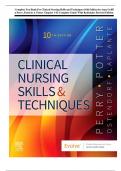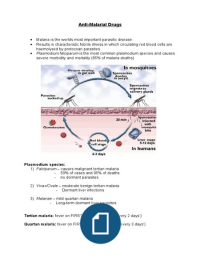Complete Test Bank For Clinical Nursing Skills and Techniques 10th Edition by Anne Griffi
r
n Perry, Patricia A. Potter Chapter 1-43 Complete Guide With Rationales Revised Edition
r
,Complete Test Bank For Clinical Nursing Skills and Techniques 10th Edition by Anne Griffi
r
n Perry, Patricia A. Potter Chapter 1-43 Complete Guide With Rationales Revised Edition
r
Complete Test Bank For Clinical Nursing Skills and Techniques 10th Edition by Anne Griffi
r
n Perry, Patricia A. Potter Chapter 1-43 Complete Guide
r
Table Of Content
Chapter 1. Using rEvidence in Nursing Practice Ch
apter 2. Communication andr Collaboration Chapt
er 3. Admitting, Transfer, and DischargerChapter 4
. Documentationrand InformaticsrChapter 5. Vitalr
Signs
Chapter 6. Health Assessment Chap
ter 7. Specimen Collection Chapter
8. Diagnostic Procedures Chapter 9.
Medical Asepsis Chapter 10. Sterile
Technique
Chapter 11. Safe ClientrHandling and Mobility(SPHM) Chapt
er 12. Exercise and Mobility
Chapter 13. SupportrSurfaces and Special Beds Ch
apter 14. ClientrSafety
Chapter15. DisasterPreparedness C
hapter 16. PainrManagement Chapte
r 17. End-of-LiferCare
Chapter 18. Personal Hygieneand Bed Making Ch
apter 19. Care of the Eye and Ear
Chapter 20. SaferMedication Preparation C
hapter 21. Nonparenteral Medications Cha
pter 22. Parenteral Medications Chapter 2
3. OxygenrTherapy
Chapter 24. Performing Chest Physiotherapy Chap
ter 25. Airway Management
Chapter 26. Cardiac Care
Chapter 27. Closed Chest Drainage Systems Chapter
28. Emergency Measures for Life Support
Chapter29.Intravenousand Vascular Access Therapy Chapter
30. Blood Therapy
Chapter 31. Oral Nutrition Chapter
32. Enteral Nutrition Chapter 33. P
arenteral NutritionrChapter 34. Uri
nary Elimination
Chapter 35. Bowel Eliminationand GastricrIntubation Chapter
36. Ostomy Care
Chapter 37. Preoperativeand Postoperative Care C
hapter 38. IntraoperativerCare
Chapter 39. Wound Careand Irrigations
Chapter 40. Impaired Skin Integrity Prevention and Care Chapt
er 41. Dressings, Bandages, andrBinders
Chapter 42. Home Care Safety Chap
ter43. HomeCarerTeaching
,Complete Test Bank For Clinical Nursing Skills and Techniques 10th Edition by Anne Griffi r
n Perry, Patricia A. Potter Chapter 1-43 Complete Guide With Rationales Revised Edition
r
Chapter 01: Using Evidence in Nursing Practice
r
Perry et al.: Clinical Nursing Skills & Techniques, 10th Edition
MUL MULTIPLETIPL CE r
1. Evidence-based practice is a problem-
solving approach to making decisions about client care that is grounded in:
a. the latest information found in textbooks.
b. Systematically conducted research studies.
c. tradition in clinical practice.
d. quality improvement and risk-management data.
CORRECT: B
The best evidence comes from well-
designed, systematically conducted research studies described in scientific journals. Portions of a
textbook often become outdated by the time it is published. Many health care settings dornotrhaver
a process to help staff adopt new evidence in practice, and nurses in practice settings lack easy acc
ess to risk-
management data relying instead on tradition or convenience. Some sources of evidence do not o
originate from research. These include quality improvement and risk-
management data; infection control data; retrospective or concurrent chart reviews; and clinician
s‘ expertise. Although
non–research-
based evidence is often very valuable, it isrimportantrthat you learn tor rely more on
research- based evidence.
DIF: Cognitive Level: Comprehension OBJ: Discussthebenefits ofevidence-
based practice. TOP: Evidence-Based Practice KEY: Nursing Process Step: Assessment
MSC: NCLEX: Safer and Effective Care Environment (management of care)
2. When evidence-based practice is used, client care will be:
a. standardized for all.
b. unhampered by client culture.
c. variable according to the situation.
d. safe from the hazards of critical thinking.
CORRECT: C
Using your clinical expertise and considering clients‘ cultures, values, and preferences ensures
that you will apply available evidence in practice ethically and appropriately. Even when
you use the best evidence available, application and outcomes will differ; as ar nurse, you will
devel op critical thinking skills to determine whether evidence is relevant and appropriate.
DIF: CognitiveLevel: Application OBJ: Discuss the benefits of evidence-
based practice. TOP: Evidence-BasedrPractice KEY: Nursing Process Step: Assessment
MSC: NCLEX: Saferand EffectiverCare Environment (management of care)
3. When a PICOT question is developed, the letter thatrcorrespondsrwithrtherusualrstandard of car
e is:
a. P.
b. I.
c.
, Complete Test Bank For Clinical Nursing Skills and Techniques 10th Edition by Anne Griffi r
n Perry, Patricia A. Potter Chapter 1-43 Complete Guide With Rationales Revised Edition
r
Q&A
BuyBuyr an d and S e l l S e l l r youryourr StudyStudyr MaterialMaterial
c. CHOICE BLANK
d. O.
CORRECT: C
C = Comparison ofrinterest. What standard of care or current intervention do yourusually use now i
n practice?
P= Clientpopulationrof interest. Identify your client byage, gender, ethnicity, disease, or healthr
problem.
Ir= Intervention of interest. What interventionr(e.g., treatment, diagnostic test, and prognostic factor)r
do you think isr worthwhile to userinrpractice?
O = Outcome. Whatrresultr(e.g., change inrclient‘srbehavior, physical finding, and change inrclient ‘s
perception)rdo you wish torachieve or observeras the resultrof anrintervention?
DIF: CognitiveLevel: Knowledge
OBJ: Developa PICOquestion. TOP: PICO
KEY: Nursing ProcessrStep: Implementation
MSC: NCLEX: Saferand EffectiverCare Environment (management of care)
4. Awell-developed PICOT question helps thenurse:
a. search for evidence.
b. include all five elements of the sequence.
c. find asrmany articles asrpossiblerinra literature search.
d. acceptstandard clinical routines.
CORRECT: A
The more focused a question that you ask is, the easier it is to search for evidence in therscientific li
terature. Awell-
designed PICOT question does not have to include all five elements, nor does it havertorfollow the
PICOT sequence. Do not be satisfied with clinical routines. Always question and usercritical think
ingto consider better ways toprovide client care.
DIF: CognitiveLevel: Analysis OBJ: Describethersix steps of evidence-
based practice. TOP: Evidence-Based Practice KEY: Nursing Process Step: Implementation
MSC: NCLEX: Saferand EffectiverCare Environment (management of care)
5. The nurse is not surerthat the procedure the client requires is the best possible for the situatio
n. Utilizing whichrof therfollowing resources would bertherquickest wayto review research o
n the topic?
a. CINAHL
b. PubMed
c. MEDLINE
d. The Cochrane Database
CORRECT: D
The Cochrane Community Databaserof SystematicrReviewsris a valuable sourcerof synthesized e
vidence (i.e., pre-
appraised evidence). The Cochrane Database includes the full text of regularly updated systemati
c reviews and protocols for reviews currentlyhappening. MEDLINE, CINAHL, andrPubMed are
among the most comprehensive databasesrand represent therscientific knowledgerbaserof health c
are.
DIF: CognitiveLevel: Synthesis OBJ: Describethesixsteps of evidence-
based practice. TOP: Evidence-Based Practice KEY: Nursing Process Step: Implementation





